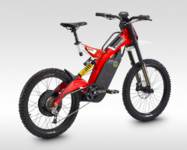m@Robertson
Well-Known Member
- Region
- USA
Interesting. I am a big advocate of awd/2wd ebikes for their increased traction and their general 'just works better' nature. Also they are well suited to a utility bike (not a recreational one) that is supposed to be an auto replacement.
Van Moof is going there, it seems. Bravo.
Looks like they are using an integrated, inverted front fork to overcome the inherent weakness of traditional suspension forks coupled to a motor. I am sure a highly engineered bike like this has some smarts integrated into the controller that commercial 2wd bikes of the present day lack.

 electrek.co
electrek.co
Van Moof is going there, it seems. Bravo.
Looks like they are using an integrated, inverted front fork to overcome the inherent weakness of traditional suspension forks coupled to a motor. I am sure a highly engineered bike like this has some smarts integrated into the controller that commercial 2wd bikes of the present day lack.

VanMoof unveils 31 mph 'hyperbike' electric bicycle with two motors and full suspension
VanMoof has just announced a new high-speed electric bicycle model known as the VanMoof V, which will reach speeds of...
 electrek.co
electrek.co


